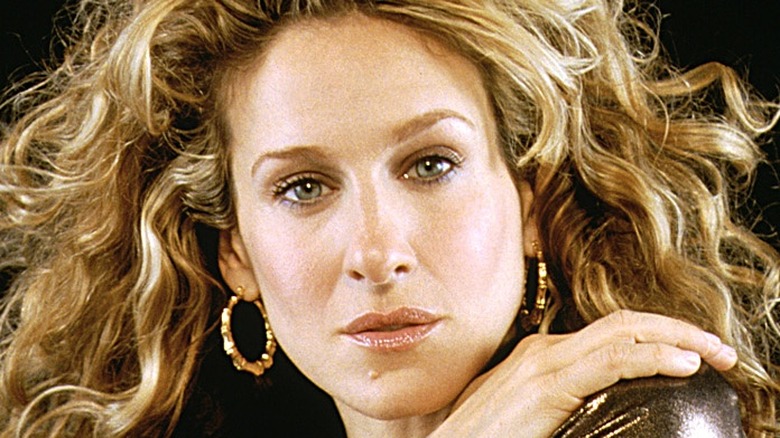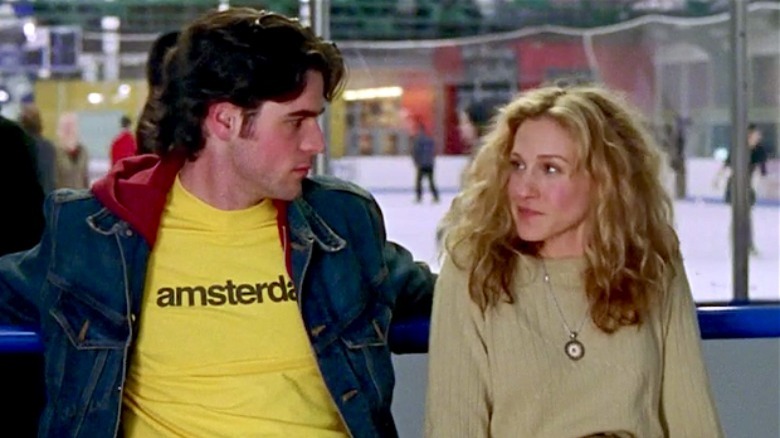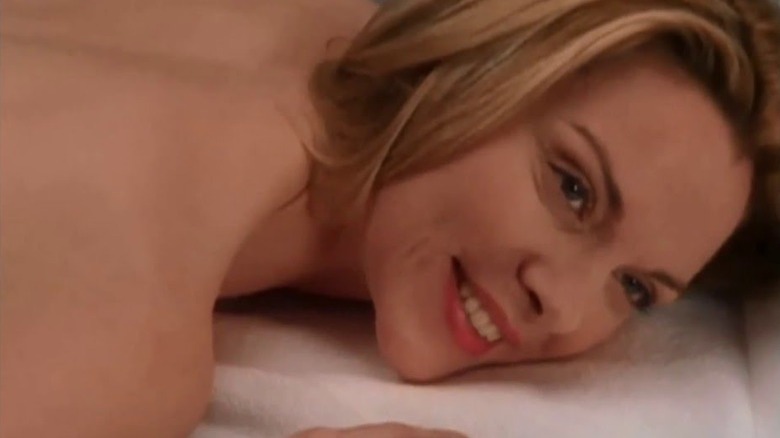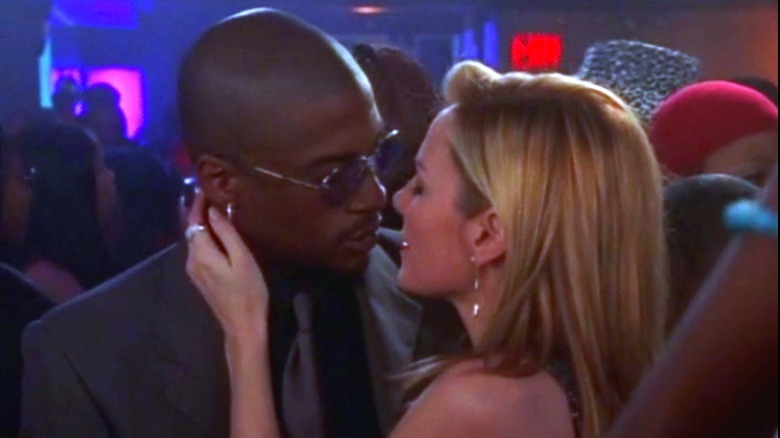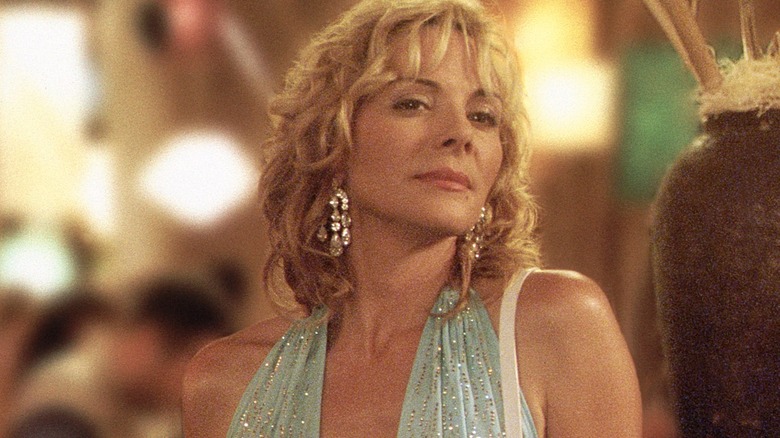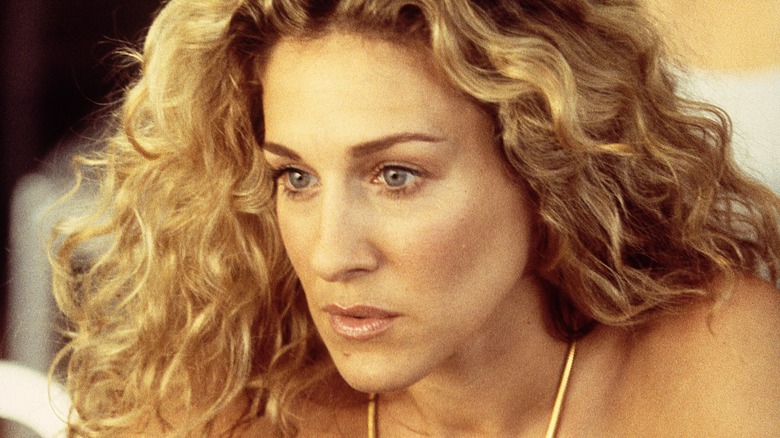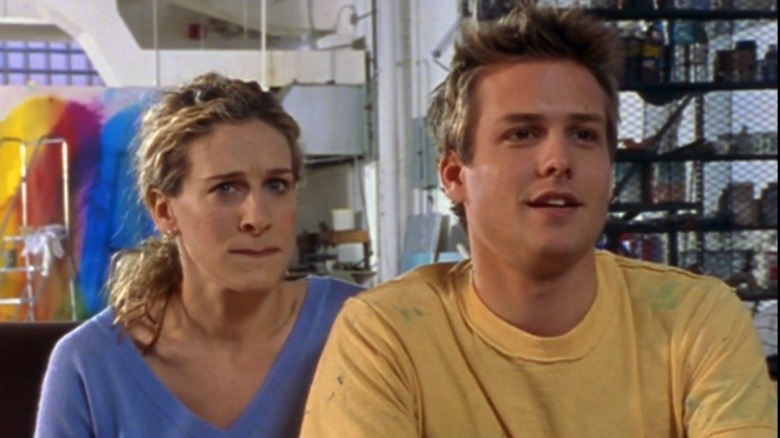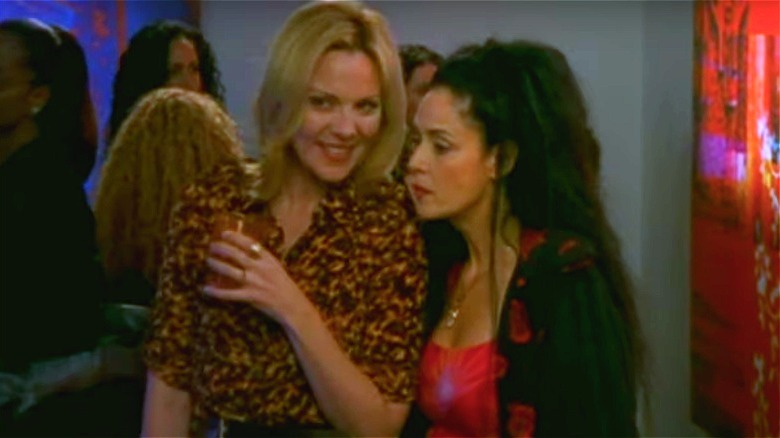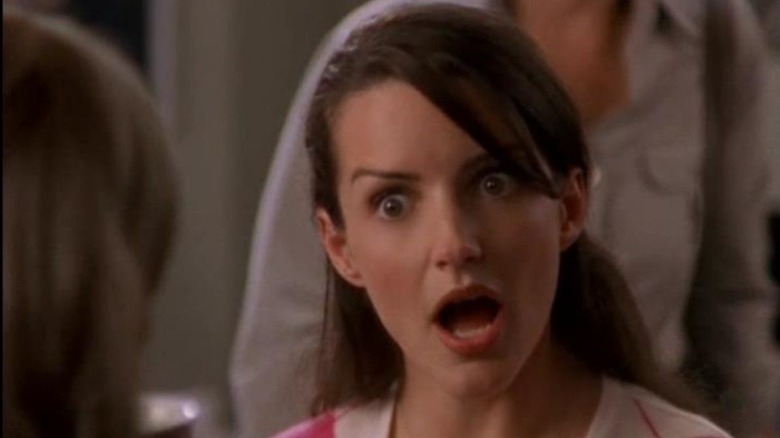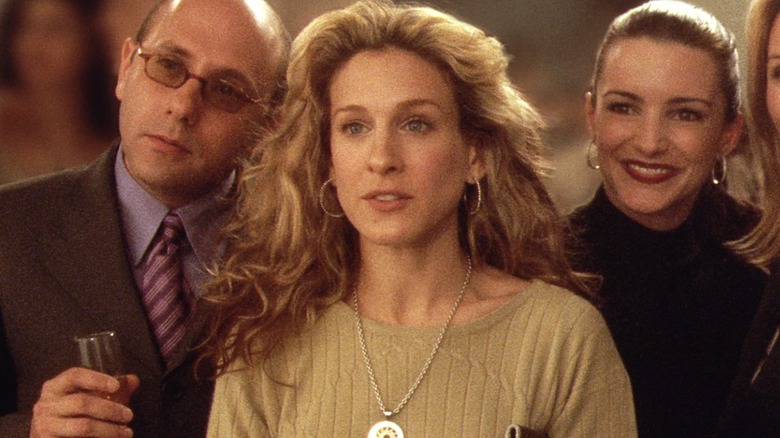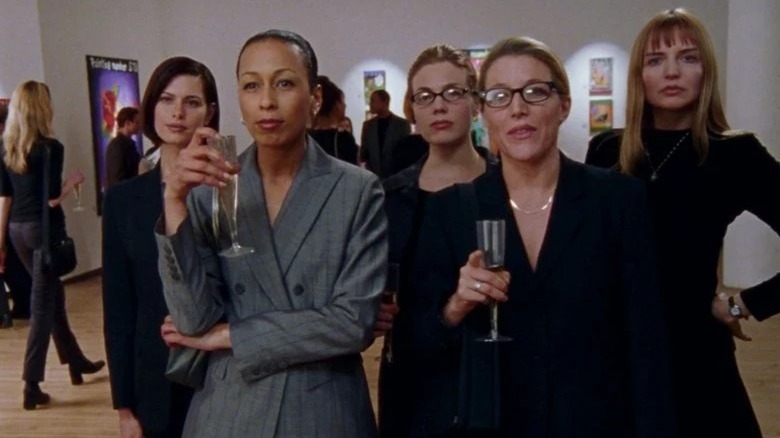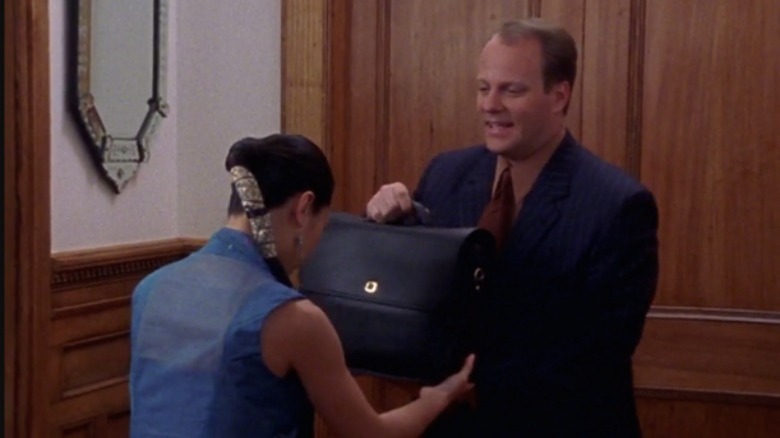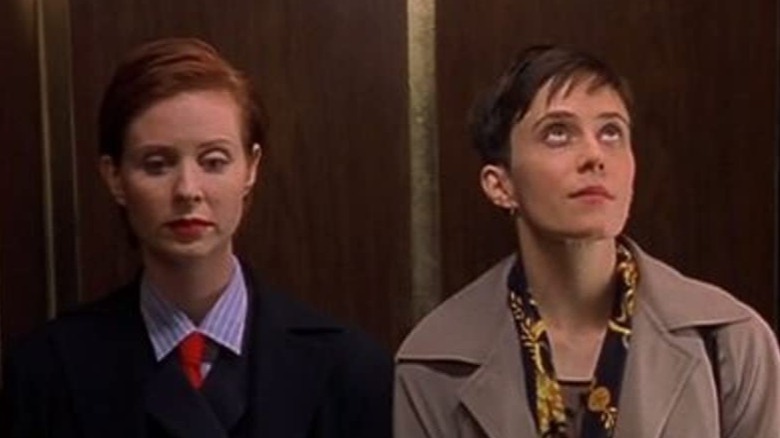Sex And The City Moments That Haven't Aged Well
"Sex and the City" is an iconic television show that pushed the boundaries of what was acceptable to feature on TV, and that helped define HBO as a forward-thinking, outside-the-lines network. The show was immensely popular when it aired (from 1998 to 2004), and it continues to live on in both reruns and cultural conversation. In fact, the end of 2021 sees the series continuing in the form of a reboot entitled "And Just Like That...," which is sure to renew interest even further in Carrie Bradshaw and her crew.
For all of its popularity, "Sex and the City" also has many critics — some of whom critiqued the show when it was on the air, but many of whom have reassessed it in the decades since. And while some people hate just to hate, there are valid things to gripe about when taking a current-day lens to the show. In fact, even the original creative team agrees that there were some startling issues — for example, the white-washing of New York City — which they seem to want to redeem themselves for this time around (via HuffPost).
While we can't help but love "Sex and the City" for the way it focused squarely on women who unapologetically (for the most part) spoke openly and frankly about female sexuality — and for its fantastic mix of dramatic heartbreak and sidesplitting humor — there are a lot of storylines that just don't hold up in 2021. Here are some "Sex and the City" moments that have not aged well.
When the ladies discussed bisexuality
For all of her openness about sex and relationships, Carrie Bradshaw was actually not an open-minded person. Case in point: the episode "Boy, Girl, Boy, Girl," where Carrie expresses some deeply misguided views about bisexuality. In the Season 3 episode, Carrie goes on a date with Sean, a younger man who takes her ice skating and then proceeds to tell her that he has had romantic relationships with both men and women.
And then Carrie — a sex columnist! — loses her mind. Cut to brunch, where Carrie immediately launches into how weird it was that Sean would be open about his bisexuality. "Of course, it's a problem," Miranda chimes in. After Samantha offers a more enlightened view, the ladies then go on to conflate sex and sexual orientation, stereotype a whole generation, and — most problematically — question the validity of bisexual identities. "I'm not even sure bisexuality exists," Carrie quips. "I think it's just a layover on the way to Gaytown."
If that all was not icky enough, Miranda also calls Sean "greedy," drawing upon a really untrue but oft-repeated stereotype about bisexuals (and that it was not the more conservative Charlotte but hardcore Liberal feminist Miranda makes no sense whatsoever). For a show that highlighted gay characters at a time when there were not many on TV, "Sex and the City" sure dropped the ball on this topic. The bi-erasure and biphobia were shocking then, and it's plain unwatchable now.
When Samantha committed a sex crime
Look, we love Samantha Jones just like everyone else. Kim Cattrall has amazing comedic timing, and the character had some of the funniest storylines and the best dialogue. But that does not excuse the fact that Samantha committed a sex crime, which the show treated as something to be laughed at. In the Season 3 episode "Attack of the Five Foot Ten Woman," viewers see Samantha excitedly book a massage with Kevin, a masseur that another client told her will please her sexually as part of his services. When he does not make a move on Samantha, she decides to grope him. She grabs his junk — without consent — and gets thrown out of the spa for it.
But really, let's call it what it is — a sex crime. Kevin complained, Samantha was no longer welcome there, and that was the end of the story. Never does Samantha seem to realize that what she did was wrong, let alone apologize or face real consequences. When told she could no longer return to the "civilized" spa, Samantha claims, "this isn't my fault" and admitted to only booking the appointment because she knew "Kevin went down on another customer." We really cannot see a scenario where — if Samantha was the one to have been unwillingly groped by the masseur — it would have been treated with the same lack of seriousness.
If you or anyone you know has been a victim of sexual assault, help is available. Visit the Rape, Abuse & Incest National Network website or contact RAINN's National Helpline at 1-800-656-HOPE (4673).
When Samantha dated a Black man
Season 3's "No Ifs, Ands, or Butts" is an important "Sex and the City" episode because it is the one where Carrie first meets Aidan, but it is also a big mess when it comes to race (which the show never, ever did well). From the way it framed Black women to the way Samantha engaged in stereotypical ethnic performance, the entire storyline of Samantha's interracial love affair was mishandled.
In the episode, Samantha dates a man named Chivon, an African American record executive who inexplicably wears sunglasses indoors and has a sister, Adeena, who does not want her brother dating outside his race. In a climactic scene that draws on the historic angry Black woman stereotype, Adeena tells Samantha that she does not "belong" in the club they are dancing in, yells at her to get her "little white pu***" away from her brother, and then starts a physical altercation.
But that scene is not the only one that has not aged well. Over a meal, Samantha tells the women about Chivon's nether regions in a way that completely objectifies and fetishizes him as a Black man. She also claims to not "see color," which is widely recognized today as a deeply problematic approach to race relations. After all, as "The Real Housewives of Beverly Hills" star Garcelle Beauvais – a Black woman — explained to her castmate Kathy Hilton in 2021, "If you don't see color, then you don't see me." Amen.
Samantha's encounter with transgender women
Samantha was perhaps the funniest character on "Sex and the City," but she was also at the heart of some of the show's most problematic moments, and few storylines were more mishandled than when the show introduced us to Samantha's "struggle" with transgender sex workers outside her window. She fights with the women and eventually finds a way to win them over, but the way that these characters are referenced is utterly disgusting. From the use of slurs to describe these women to the jokes made at their expense, the storyline is deeply offensive and — unfortunately — something we might still see on TV today, given that Dave Chapelle's transphobic Netflix special, "The Closer," made it to screens (via Deadline).
While Samantha's words and actions are terrible in Season 4's "Coulda, Woulda, Shoulda," some of the worst comments come from the other ladies. Samantha goes on a tirade about the women — calling them all sorts of slurs — and Miranda responds with "I don't get the appeal there," which prompts Carrie to come back with "it's the other white meat." Per the Human Rights Campaign, at minimum 44 transgender or gender non-conforming persons have been killed thus far in 2021. Neither the fact that transgender women — and transgender women of color, in particular — engage in survival sex work because of discrimination and prejudice nor that they are disproportionately the victims of violence came up once in the entire episode.
If you or a loved one has experienced a hate crime, contact the VictimConnect Hotline by phone at 1-855-4-VICTIM or by chat for more information or assistance in locating services to help. If you or a loved one are in immediate danger, call 911.
Carrie not knowing basic computer skills
We love that Carrie was always portrayed as a lover of old media. She loved reading books, refused to get a cell phone, and was more likely to reference historic pop culture like "The Way We Were" than anything trendy. Heck, she even went to see an old French movie alone — on date night, much to Charlotte's surprise — in the Season 5 premiere episode "Anchors Away." But one place we cannot support Carrie's resistance to embrace technology is when it comes to her use of computers. Because, you know, she's a writer and all.
While the series consistently showed Carrie using a computer to write, she was made out to be incredibly dumb when it came to some of the most basic tasks. Not only did she confess that she did not back up her work — which we found out when her computer died in Season 4's "My Motherboard, My Self" – but she did not even seem to know what that meant. And in a later episode, called "Baby, Talk Is Cheap," Carrie literally ducks when her then-ex Aidan comes online, not knowing if he could physically see her or not. While it made for a funny scene, it also painted Carrie as rather dim and not at all a respectable and seasoned journalist. She did not even have an e-mail until she wanted to contact Aidan (in that same episode), which is not something any legit newspaper columnist could get away with, even in 2001.
When Carrie ignored her friend's deviancy
"Models are a lot looser than you think," exclaimed Carrie's friend Barkley when we first meet him in "Models and Mortals," the second episode of "Sex and the City." He added, "It's way easier to screw a model than a regular girl because that's what they do all the time." But we are not here to complain about the stereotyping of models — it is Barkley's habit of filming himself having sex with them that makes our list. He tells Carrie this information like it's no big deal and dismisses her question about whether they know with a noncommittal "maybe."
Viewers then see Carrie watching a video — presumably taken without the other party's consent — of a woman having sex with Barkley. Because models are demonized throughout the episode, it is almost as if they deserve this sort of treatment. After all, Carrie does nothing about it — not even a stern lecture for her little friend. She does, however, tell Samantha about the clandestine video camera when she finds out Samantha is about to go home with Barkley — because apparently, Samantha's privacy and dignity are worth something more than the New York models Carrie refers to as "creatures in their natural habitat" earlier in the episode.
When Samantha's lesbian lover was a caricature
In a Season 4 episode titled "Defining Moments," Samantha meets Maria, a lesbian artist whom she befriends at Charlotte's art gallery. When Maria falls for Samantha, Samantha tells her she does not do relationships, before completely changing her mind and going all in. Maria (played by Sonia Braga) appeared in three episodes of the show and, in that short time, managed to capture not only lesbian stereotypes but also Latina ones.
For starters, Maria was a walking ball of schmaltziness. After an initial honeymoon period, Samantha started to complain to her friends that all she did in her relationship was talk about feelings and take baths. In the process of trying to show us that Samantha was sex-driven and emotionally distant — like a man might be in a relationship — the creatives leaned too far into tired tropes about queer women and lesbian bed death.
And when an old hook-up knocked on Samantha's door in the middle of the night, Maria flipped — turning into the epitome of the fiery Latina stereotype. "I am fresh out of things to say to you. All we ever do is talk, talk, talk," yelled Samantha. "I want passion. I want fireworks." In response, Maria erupted in emotion, dramatically smashing plates and making firework sounds. While race was never a strong part of "Sex and the City, we hope that the four women of color who have joined the reboot get written far better.
Charlotte quitting work because she got married
Charlotte has always been the most conservative gal on "Sex and the City," but even Charlotte seemed to act out of character when she up and quit her job in Season 4's "Time and Punishment." While we believe that women should be able to make any life choices that work for them, Charlotte had a passion for her work that was commendable, and she always knew what she wanted out of life. Running a gallery fit her personality perfectly, and she seemed to be good at it, so the idea that the character would quit working based on the mere suggestion of her husband made no sense.
Furthermore, Charlotte had absolutely nothing to do with herself when she quit, which was out-of-character for the woman who always seemed to have a determined plan. "But there's so much more I could do with my life," she told the other gals. In addition to getting pregnant, other goals included decorating her apartment, taking an Indian cooking class, and doing pottery — all of which she could have done while still working at the job she adored. She could have left after getting pregnant, and that may have been more realistic, but there is no legitimate reason why she needed to hire a replacement and leave the job she so dearly loved with no baby on the horizon. The other ladies did not get it — Charlotte and Miranda even got into a fight — and neither did we.
When we learned Carrie doesn't vote
There are so many wonderful storylines on "Sex and the City" that it is still possible to watch it back and feel all sorts of raw emotions. But one episode that strikes pure frustration is the Season 3 episode "Politically Erect." This is the episode where Carrie meets a handsome politician (played by John Slattery) who is running for city comptroller. It is also the episode where we learn that Carrie — a woman with her face on the side of New York City busses — knows nothing about city politics.
"I can't believe you're dating a politician! You're not even registered to vote," exclaimed Charlotte when she found out about Carrie's new flame. If Carrie were 24 and living with her parents, perhaps the idea that she would not register to vote would, well, register. But this was a single woman in one of the most expensive cities in the world who should have been concerned about things like taxes, rent stability, and transportation (to name a few issues). Not to mention that she was a journalist who — in theory — should have had a vested interest in women's health, arts, and city life simply based upon her job.
The gang of lesbians that rejected Charlotte
Despite being created by a gay man (Darren Star, the mastermind behind "Emily in Paris," as well), "Sex and the City" was always a show that relied a little bit too much on stereotypes when it came to its queer characters. Anthony was a catty, hypersexual event planner, for example, and Stanford was routinely rolled in covered in scarves and paisley whenever Carrie needed a gay best friend as a prop. In 2019, Vogue even wrote an article about how awful Carrie treated Stanford, her "gay husband."
When it comes to lesbians, Samantha's fling Maria (for three episodes) was pretty much the most we got. The one other episode to prominently feature lesbian characters was "The Cheating Curve," a Season 2 episode where Charlotte meets a group of "power lesbians." To this day, we are still not sure what gives these lesbians their special superhero powers, but awful name aside, the gang of queer women was pretty terrible to Charlotte. They stopped hanging out with her the second they found out she was not gay — right after she gave an impassioned speech about how much she loved their company — implying that lesbians are incapable of platonic friendship with straight women, and drawing upon the tired trope of the angry, unfriendly lesbian.
When Samantha's boyfriend had a servant
In Season 2's "The Caste System," Samantha is seen dating a successful real estate agent named Harvey Terkell. In typical Samantha fashion, she loved his penthouse but found herself going up against the other primary woman in his life — not his mother, daughter, or even ex, but his servant. Yes, the man had a literal servant — an Asian woman named Sum. While a wealthy man with an immigrant female living in his home could have made for a meaningful storyline, this was far too surface level to give us what we needed.
For one thing, Samantha should have walked out the door the second she learned of Sum's existence. A single man with a caretaker who caters to his every whim is one of the least sexy things in the world. Also, Samantha had no problem with Sum when she was being indulged, but only started to sour when she realized Sum was not the same person when her employer was not around. Samantha signing off on the arrangement — particularly the subservient way that Sum was made to talk and act around Harvey — was totally cringeworthy. Upon repeated viewing — and especially knowing that this is one of the few Asian faces we would ever see on "Sex and the City" — this episode just does not work.
When Miranda pretends to be gay
When Miranda was mistaken for a lesbian in the show's third episode, "Bay of Married Pigs," we could almost get behind it. While it is not cool that Miranda's coworkers assumed she was gay — likely based upon culturally constructed stereotypes like her short hair and boxy suits — it spoke to the reality of the stereotyping that we do in our society. People continue to conflate gender performance and sexual orientation erroneously, and so the storyline felt true in that sense.
Miranda's explained to her coworker that she was not gay, and she also informed Sid, the poor woman who was brought out to be set up on a blind date with her. But here is where the show lost us — after playing baseball together, Miranda's boss invites her and Sid to a dinner party, and Miranda says yes. "I'm determined to make partner at this firm, even if I have to be a lesbian partner," Miranda tells Carrie.
Straight characters being mistaken for gay? Fine. Straight characters actually pretending to be gay for the advancement of their careers? Not cool. It downgrades the actual struggles that LGBTQ people continue to deal with in the face of overt and covert discrimination and prejudice and makes queer identity into a performance. And, also, in no world is being a single straight person more difficult — or judged more harshly — than being a queer person, not even in Liberal 'ole New York City.
